Vasily Vereshchagin Biography
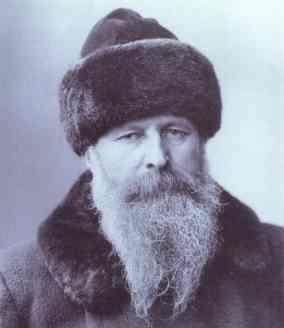
Vasily Vasilievich Vereshchagin (also spelled Vereschagin) (1842-1904) was a Russian Realist painter of the second half of the 19th Century, best known for his depictions of battle scenes, both contemporary and historical. He was one of the first Russian painters to be widely recognized outside of his native country and had numerous exhibitions in Europe and the USA. Although his success was founded on the subject matter of war and combat, and despite being a highly decorated military officer, the artist was an outspoken critic of all war, which often put him in conflict with the ruling powers of the time.
Vereshchagin was born on October 14, 1842, in Cherepovets, Russia into the relatively prosperous family of a landowner.
As the son of a landowner and nobleman, Vereshchagin was expected to follow a military or diplomatic career. At the age of eight, his parents enrolled him in the Alexander Cadet School, an educational institution in St. Petersburg that prepared future military officers from a very early age. Subsequently, he entered the Naval Academy from which he graduated with honors in 1860. Vereshchagin was one of the ablest students in his class and looked to be at the outset of a promising Naval career.
However, during the years of his education in the military arts, the young man had developed a passion for fine art -- viewed as a "lower-class" calling by his peers. He had begun attending evening classes at the St. Petersburg Academy of Arts as early as 1858 and, in 1860, immediately upon graduating from the Naval Academy, enrolled full-time at the Academy of Arts.
The Academic education of the time was based entirely on the principles of late Classicism, which was not wholly satisfactory to the young man. Despite receiving a Minor Silver Medal for Ulysses Slaying the Suitors of Penelope, he destroyed the painting, saying that he would not paint such nonsense any longer, and left the Academy. The same year (1864) he entered the Academie des Beaux-Arts in Paris where he studied under the famous Jean Leon Gerome. But in the Paris Academy, too, classical standards and the practice of copying from the antique and the masterpieces of the past were prevalent.
In search of new subjects, Vereshchagin traveled to the Caucasus, where he created a series of sketches and studies, devoted to the life and customs of the local peoples. In 1867, he volunteered for service in the Russian army in Turkestan (a region encompassing parts of present-day Kazakhstan, Kyrgyzstan, Tajikistan, Turkmenistan and Uzbekistan) and participated in military actions against the Emir of Bukhara. For his bravery in the defense of Samarkand he was awarded the highest military decoration of Russia: the Order of St. George. His "Turkestan series," painted on the basis of sketches and studies done during the war, also brought him considerable fame and recognition in the Russian upper class. The paintings Rejoicing and Presenting the Trophies, in which Muslim fighters brandish the severed heads of Russian soldiers, are the most famous in the series.
Many of the Central Asian works did not sit well with Vereshchagin's commanders because of their perceived "lack of patriotism." The painter strove to depict the realities of the campaign as faithfully as possible, showing Russian defeats and the often-tragic fate of Russian soldiers in graphic detail. As a result, the painter was forced to destroy some of the works.
Soon thereafter, he left Russia for two years.
Scenes of Central Asian barbarism and death made a great impression on the artist. Philosophical reflections on the catastrophic consequences of all war are reflected in his picture The Apotheosis of War (1871), which shows a pyramid of skulls amidst a burnt desert, and the ruins of a city in the background. On the frame the painter wrote his dedication "to all conquerors, who were, who are, and who will be": an unambiguous condemnation of war.
In 1877-78, Vereshchagin fought in the Russo-Turkish war on the Balkan Peninsula. Though opposed to war, he felt that it was his duty to document it in all its detail, and since the profession of war correspondent had not yet been recognized in Russia, the artist got around this obstacle by volunteering for active duty. In this position, Vereshchagin never shirked his duty and was always in the thick of the fray. He was wounded several times. Vereshchagin hated to see the death, often pointless, of simple soldiers, be they Russians or Turks. Therefore he depicted both, never letting his patriotic feelings degenerate to nationalism or chauvinism. Unlike most contemporary battle pieces depicting war as a kind of glorious parade, Vereshchagin's paintings revealed its viciousness, showing soldiers as the most important element in war and the chief victim of it.
In the Balkan Series, Vereshchagin was able to show some of the Russian commanders' incompetence and recklessness, which resulted in a serious conflict with the government. Alexander II said that Vereshchagin was "either scum, or a madman." The painter had to leave Russia once again. He had successful exhibitions outside Russia, but both in Europe and in the USA, military authorities forbade soldiers and students of military schools to visit the exhibitions.
During his two trips to India (in 1872-74, 1882-83) he created his celebrated Indian series, featuring a variety of subjects and techniques, from skillfully done sketches of architectural monuments to deeply psychological portraits and genre scenes. The subject matter of some of the paintings was the oppression of the Indian people resulting from British colonial rule.
A journey to Syria and Palestine in 1888, resulted in a set of paintings on subjects from the New Testament, which Vereshchagin treated rather unconventionally. The series was severely censored in Catholic countries and banned in Russia. At an exhibition in Vienna, a religious fanatic used acid to destroy two paintings: The Holy Family and The Resurrection.
It was not until the early-1890s that Vereshchagin was at last able to return to Russia. The painter settled in Moscow where he dedicated what would turn out to be the last 15 years of his life to a series of paintings devoted to Napoleon's unsuccessful Russian campaign and the War of 1812. Though executed in his harsh, realistic style, these works are much more romanticized and patriotic than his earlier paintings.
In 1901-1903, Vereshchagin traveled to the Philippines, USA, Cuba, and Japan. His work on his Japan series was interrupted by the outbreak of the Russo-Japanese war.
A partisan of peace, Vereshchagin died the death of a soldier. He perished aboard the Russian flagship Petropavlovsk, on April 13, 1904, when it hit a mine and sank, with all hands lost.
Bibliography
Vereshchagin by A. Lebedev & A. Solodovnikov. Russian Painters of the XIX Century. Moscow. 1987.
- The Apotheosis Of War.
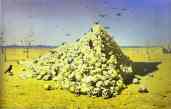
1871. Oil on canvas. The Tretyakov Gallery, Moscow, Russia.
- Ruins In Chuguchak.
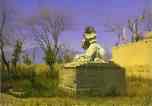
1869. Oil on canvas. The Russian Museum, St. Petersburg, Russia. Read Note.
- Cannibal.

1870s-1880s. Oil on canvas. The Museum of Art, Nikolayev, Ukraine.
- At The Fortress Walls. "Let Them Enter!".

1871. Oil on canvas. The Tretyakov Gallery, Moscow, Russia. Read Note.
- The Doors Of Tamerlane.
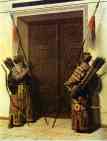
1872-1873. Oil on canvas. The Tretyakov Gallery, Moscow, Russia. Read Note.
- Uzbek Woman In Tashkent.

1873. Oil on canvas. The Tretyakov Gallery, Moscow, Russia.
- At The Door Of A Mosque.
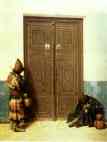
1873. Oil on canvas. The Russian Museum, St. Petersburg, Russia. Read Note.